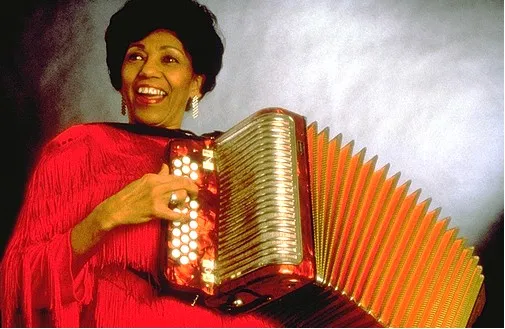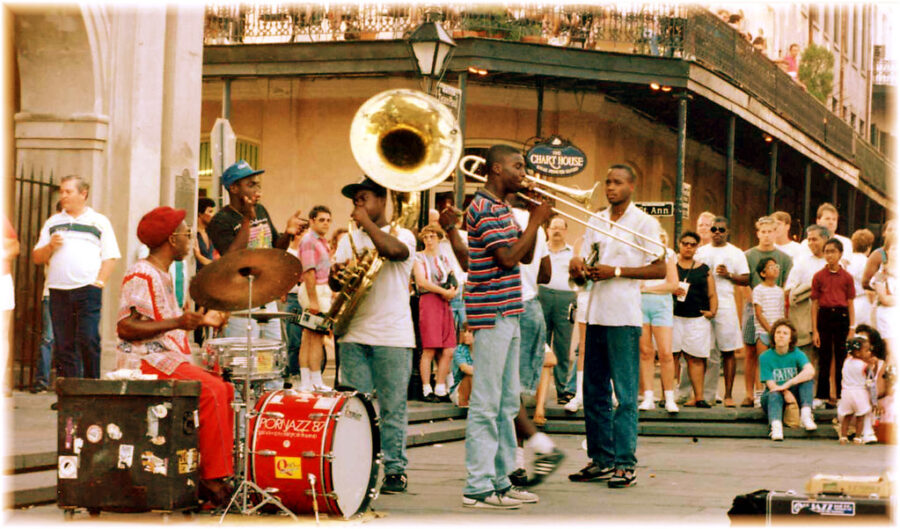Fats Domino and the Sound of New Orleans
The New Orleans sound reflects the diversity and eccentricity of the local culture. Fats Domino ignited its first rock ‘n’ roll soundtrack.
New Orleans, Louisiana
New Orleans became a world music capital because of the musical legacies of its diverse populations: French, Spanish, African, English, Caribbean, Acadian (Cajun), and Creole (Zydeco). Their musical interactions created a flamboyant, “chunky,” horn-based soundtrack that is instantly recognizable as the New Orleans sound.
All of the genres that fused the genesis of rock ‘n’ roll–jazz, the blues, R&B, gospel, and country–had their heyday in “The Big Easy.” It took the likes of Fats Domino to become New Orleans’ first rock ‘n’ roll hitmaker. Fats was in the right place at the right time.
First and foremost, New Orleans is known for its jazz.
Jazz
Jazz began in New Orleans at the turn of the 20th century, according to the Smithsonian. Some speculate that jazz grew from “drumming and voodoo rituals” in the town squares in the prior century. Soon, brass ensembles were playing in Black funeral marches and the Mardi Gras parade.
The first New Orleans jazz ensemble is believed to be led by Buddy Bolden, whose band began playing in 1895 in the notorious Storyville “red light district” until city authorities raided and closed the district in 1917. Besides Bolden, New Orleans can claim a lion’s share of jazz greats: Louis “Satchmo” Armstrong, King Oliver, Edward “Kid” Ory, Louis Prima, Al Hirt, Pete Fountain, and the Marsalis family of Ellis, Wynton, and Branford.
The Blues
US Highway 61 connects New Orleans to the famous “Blues Highway” that travels through northwest Mississippi to Memphis, Tennessee. The original “delta blues” was born in those Mississippi farming towns where cotton was king and where you could find a Black man with a guitar and harmonica singing country blues.
New Orleans was fortunate to be both physically and spiritually connected to blues music’s ground zero. The city carved out its own blues tradition that was more “piano- and horn-driven…enlivened by Caribbean rhythms…with a ‘second line’ strut of Dixieland music.”
Professor Longhair
Professor Longhair was the first New Orleans blues practitioner to gain limited fame and sign a record contract. He refined rugged barrelhouse piano playing into “the foundation for a bass-centered rhythm and blues,” through the depth of his songwriting and his fearless instinct of what pleased an audience.
Here is Professor Longhair accompanied by the Meters playing ‘Fess’s classic song “Tipitina,” live on the PBS Soundstage in 1974, published by Bob R via YouTube.
Rhythm and Blues
Professor Longhair was indeed on to something. This exciting new sound put the rhythm (and a full ensemble) into 12-bar blues. All it needed was a facilitator or two to create and produce songs that were bankable yet retained a genuine New Orleans flavor. Enter Dave Bartholomew and Cosimo Matassa.

Fats Domino, Cosimo Matassa, and Dave Bartholomew reunited at Matassa’s J&M Studio on North Ramparts St. in New Orleans. Photo by Jennifer Zoon/nola.com
Dave Bartholomew, songwriter, bandleader, and Satchmo-inspired trumpeter, is best known for co-writing hits for Fats Domino (we’ll get to him). But Bartholomew was active in many musical genres in his hometown, amassing more than a hundred entries on the pop and R&B charts.
In his induction into the Rock and Roll Hall of Fame, Bartholomew was cited as the “key figure in the transition from jump blues and swing to R&B and…was a true pioneer in the rock and roll revolution.” Bartholomew died in 2019 at the age of 100.
Cosimo Matassa and the Sounds of New Orleans
Another unheralded yet legendary figure shaping the New Orleans sound was Cosimo Matassa, a recording engineer who founded J&M Studios, which is now a historic landmark. Performers such as Little Richard and Ray Charles flocked to Matassa’s studio in search of that sublime New Orleans sound that could only come from Big Easy session players and Cosimo’s native-born talent.
The list of songs recorded by Matassa could be a New Orleans greatest hits record: Lloyd Price’s “Lawdy Miss Clawdy,” Professor Longhair’s “Mardi Gras in New Orleans,” Little Richard’s “Tutti Frutti,” Ernie K-Doe’s “Mother-In-Law,” Aaron Neville’s “Tell It Like It is,” Shirley & Lee’s “Let the Good Time Roll,” Robert Parker’s “Barefootin’,” and recordings by Irma Thomas, the “Soul Queen of New Orleans.” And, of course, Fats Domino’s prolific catalog.
Fats Domino and the Advent of Rock ‘n’ Roll
Antoine Dominique Domino, Jr., a.k.a. Fats Domino (1928-2017), reveled in his status as a rock ‘n’ roll pioneer but was first and foremost a hit-maker: 65 million records sold over a period of 20 years, earning Fats more gold records than anyone except Elvis and the Beatles.
Fats’ ability to crossover to a multi-racial genre was made possible by his “warm vocal style and a thick, chunky, boogie-woogie-based New Orleans-flavored piano.” Fats performed with great charm and humility, which ingratiated him to audiences in the fifties.
Here is Fats Domino’s first hit record, “The Fat Man,” a 2+ minute video filled with great graphics, published by 01musicfan via YouTube:
Crossing Over
He could be singing the national anthem, and you’d still know by the time he sang two words, it was him, obviously, unmistakably, and pleasurably, him.
—Cosimo Matassa on Fats Domino
The collaboration on “The Fat Man”–Fats behind the keyboard, Cosimo Matassa behind the recording console, and lurking nearby, producer, arranger, and co-writer Dave Bartholomew–was a tried-and-true formula that kept the hits coming for years to come. When the new rock ‘n’ roll market emerged in the mid-fifties, the trio was ready.
According to Rolling Stone, Fats Domino “officially crossed the color line” with “Ain’t That a Shame” in 1955. Songs such as “Blueberry Hill,” “I’m Walking,” and “Walking to New Orleans” were so accessible that White performers like Ricky Nelson, Pat Boone, and even Elvis eagerly made covers.
Speaking of covers, Fats was game in 1968 when he recorded The Beatles’ “Lady Madonna,” a song tailor-made for his talents.

Queen Ida is the first woman to front a Zydeco band. She grew up in Lake Charles, LA, where French patois was the dominant language. I must have seen her Bon Temps Zydeco Band a dozen times in her eighties heyday. Source: Cotati Accordion Festival
Zydeco and Cajun
No story of the New Orleans sound is complete without mentioning genres that are indigenous to greater New Orleans and Louisiana. For example, Zydeco music evolved in southwestern Louisiana by French Creole and Native American musicians. Zydeco is played fast and syncopated and is centered on the accordion, along with a fiddle and a clicking washboard.
Cajun music is distinct from Zydeco, though both share rural Louisiana roots and about the same featured instruments (Cajuns use a triangle more than a washboard). The music comes from the French Catholic Acadians (Acadian = Cajun) who migrated to Louisiana from New Brunswick and Nova Scotia to escape British persecution. Cajun music is slower, with more ballads, Waltzes, and two-steps.
A New Orleans Playlist
Go to the Mardi Gras – Professor Longhair
Iko Iko – Dr. John
Fire on the Bayou – the Meters
Southern Nights – Allen Toussaint
It’s Raining – Irma Thomas
Maman Rosin Boudreaux – Beausoleil
Cajun Cooking – Queen Ida
Jalapeno Lena – Rockin’ Sidney
Jambalaya (On the Bayou) – Fats Domino
Tee Nah Nah – Buckwheat Zydeco
Little Liza Jane – the Dirty Dozen Brass Band
Hey Pocky Way – the Neville Brothers
Jock-A-Mo – Sugar Boy Crawford
Working in a Coal Mine – Lee Dorsey
Zydeco Boogaloo – Buckwheat Zydeco
Ball the Wall – Professor Longhair
Comment Ca Va – Queen Ida
Mos’ Scocious – Dr. John
Diggy Liggy Lo – Doug Kershaw


















































































































